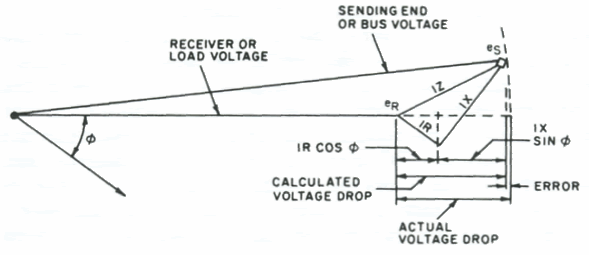You are using an out of date browser. It may not display this or other websites correctly.
You should upgrade or use an alternative browser.
You should upgrade or use an alternative browser.
voltage drop
- Thread starter Mike01
- Start date
- Status
- Not open for further replies.
- Location
- Lockport, IL
- Occupation
- Semi-Retired Electrical Engineer
I haven't seen a voltage drop formula that uses those terms. But I think you can get what you need from Table 9. The column showing "Effective Z at 0.85 pf" can be used to calculate R and X.
The former IEEE formula used those terms. The terms provided are also equivalent to the formula at the very end of the Notes to Table 9, where...charlie b said:I haven't seen a voltage drop formula that uses those terms.
Ze = R ? PF + XL sin[arccos (PF)]
...and...
PF = cos θ
sin[arccos (PF)] = sin θ
...therefore...
Ze = R cos θ + XL sin θ.
...and...
PF = cos θ
sin[arccos (PF)] = sin θ
...therefore...
Ze = R cos θ + XL sin θ.
The IEEE changed the formula a few years ago to the "exact" formula...

...leaving adjustments to R for operating conditions as an excercise for the user :grin:
The values for R and XL are in the preceding columns (i.e. if one reads left to right :wink: )But I think you can get what you need from Table 9. The column showing "Effective Z at 0.85 pf" can be used to calculate R and X.
is this right??
is this right??
In a square d catalog for busway systems it gives an example for 1000A 50% pf bus duct as follows:
Sqrt(3) * I (R cos? + X sin?)
Sqrt(3) * 1000 (.00163 *.5 + 0.00093 * .866)
What I do not understand is where are the numbers in bold derived from?
If I am right the R cos? is equal to the R value given 1.63/1000 ???
Than the Xsin? is equal to the X value (at 60hz) /1000 ???
but where does the 0.866 come from?? The sin of 60 is .866 is that for the frequency??
is this right??
In a square d catalog for busway systems it gives an example for 1000A 50% pf bus duct as follows:
Sqrt(3) * I (R cos? + X sin?)
Sqrt(3) * 1000 (.00163 *.5 + 0.00093 * .866)
What I do not understand is where are the numbers in bold derived from?
If I am right the R cos? is equal to the R value given 1.63/1000 ???
Than the Xsin? is equal to the X value (at 60hz) /1000 ???
but where does the 0.866 come from?? The sin of 60 is .866 is that for the frequency??
Umm... I don't see any numbers in bold typeMike01 said:In a square d catalog for busway systems it gives an example for 1000A 50% pf bus duct as follows:
Sqrt(3) * I (R cos? + X sin?)
Sqrt(3) * 1000 (.00163 *.5 + 0.00093 * .866)
What I do not understand is where are the numbers in bold derived from?...
The √3 operand should be obvious. The 1000(A) is given, as is the 50% power factor (which is the .5 in the equation, because cos θ = PF, as noted in my previous post). The .00163 is resistance in ohms per distance unit(s).?generally that is 1000 ft. working in the imperial system of measures. ...And the 0.00093 is inductive reactance, in the same ohms per distance measure.
No... 60 is theta(θ) in degrees (i.e. 60?). X, more appropraiately X sub L is the inductive reactance portion of the impedance in ohms per 1000 ft. (?). That value has already taken 60Hz operation into consideration. What multiplying X by sin θ does is it adjusts X for the current's phase shift from the applied voltage......Than the Xsin? is equal to the X value (at 60hz) /1000 ???
but where does the 0.866 come from?? The sin of 60 is .866 is that for the frequency??

The voltage drop formula, to eliminate the depicted error, was changed to the so-called "exact" formula I posted earlier.
Cos? and Sin? come from the power factor. PF = 0.50Mike01 said:In a square d catalog for busway systems it gives an example for 1000A 50% pf bus duct as follows:
Sqrt(3) * I (R cos? + X sin?)
Sqrt(3) * 1000 (.00163 *.5 + 0.00093 * .866)
What I do not understand is where are the numbers in bold derived from?
If I am right the R cos? is equal to the R value given 1.63/1000 ???
Than the Xsin? is equal to the X value (at 60hz) /1000 ???
but where does the 0.866 come from?? The sin of 60 is .866 is that for the frequency??
In your example Cos? =.50 and ? = 60 degrees. Sin 60 = 0.866.
- Status
- Not open for further replies.

